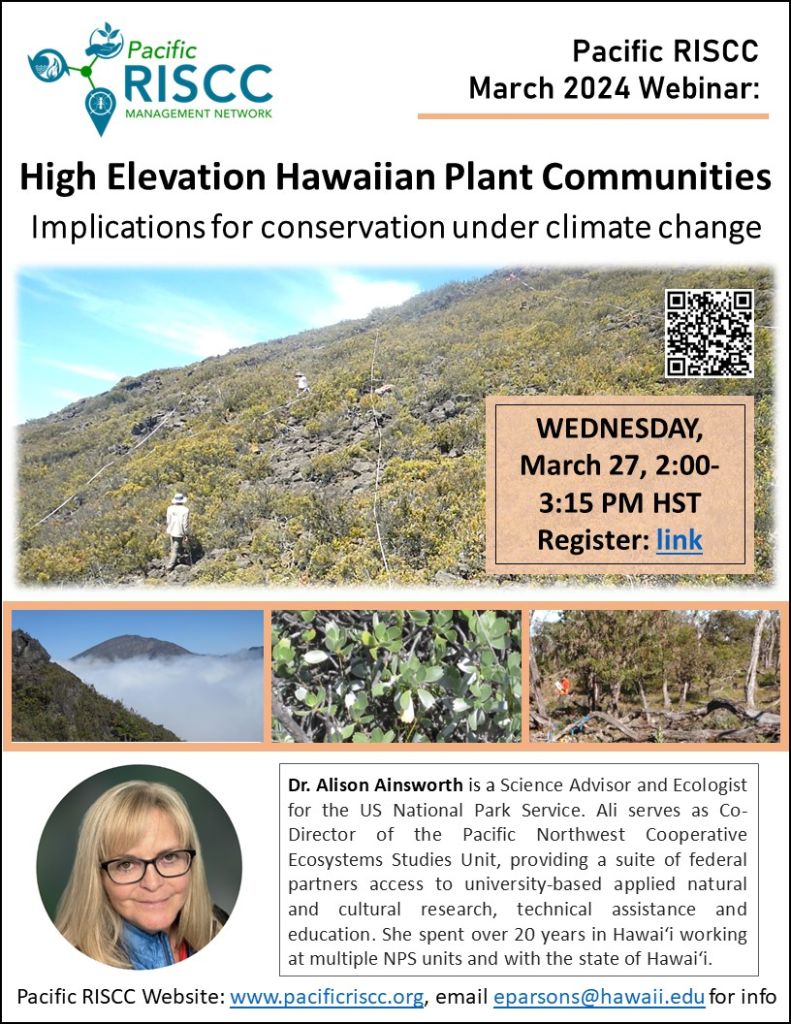High Elevation Hawaiian Plant Communities
Implications for conservation under climate change
American Sāmoa | Wednesday, March 27 from 1:00-2:15 p.m.Hawaiʻi | Wednesday, March 27 from 2:00-3:15 p.m.Palau | Thursday, March 28 from 9:00-10:15 a.m.CNMI & Guam | Thursday, March 28 from 10:00-11:15 a.m.FSM | Thursday, March 28 from 10:00-11:15 a.m. (Weno) / 11:00 am-12:15 p.m. (Palikir)RMI | Thursday, March 28 from 12:00-1:15 p.m.
A Pacific RISCC Webinar via Zoom
Webinar Details:
High Elevation Hawaiian Plant Communities: Implications for Conservation under Climate Change
In this talk, Dr. Alison Ainsworth will discuss the vulnerability of high-elevation plant communities to both climate change and invasive species.
Webinar Abstract:
Globally, subalpine and alpine plant communities are receiving increasing attention due to disproportionately rapid warming at high altitudes, and the resultant habitat shrinkage leaving high-altitude specialists with nowhere to migrate. The Hawaiian subalpine zone (1700-3000m) is an interesting example of this potential phenomenon because of high species endemism and a relatively stable, well-defined lower boundary driven by the trade wind temperature inversion capping cloud development. This boundary has been identified as an important floristic break where the onset of climate change may be easily detected. We analyzed plant species richness, cover, and density within the subalpine zone and the adjacent treeline ecotone of Haleakalā and Mauna Loa volcanoes on Maui and Hawaiʻi islands, respectively. The sampled communities spanned from sparse endemic Vaccinium and indigenous Leptecophylla subalpine shrublands above the trade wind inversion layer to endemic Metrosideros dominated wet forests. We quantified habitat specialization for 170 plant species using species co-occurrence data to rank species’ realized habitat niche breadth using the Jaccard index. We then applied these rankings to plants within the Hawaiian treeline ecotone to compare vegetation types and assess the sensitivity of climatic boundaries. Within the highest elevation vegetation types – subalpine shrublands and woodlands – the synergistic effects of invasive plant species and climate change are increasing threats even within conservation lands. I will highlight species likely to be especially vulnerable to climate change due to narrow habitat niche breadth and will emphasize the increasing threat of non-native species. These data provide a critical baseline description of high elevation vegetation and demonstrate the importance of moisture availability in this zone.
Speaker details:
Dr. Alison Ainsworth is a science advisor and ecologist for the National Park Service (NPS) and an affiliate assistant professor in the School of Environmental and Forest Sciences at the University of Washington (UW). Dr. Ainsworth serves as a co-director of the Pacific Northwest Cooperative Ecosystems Studies Unit, providing a suite of federal partners access to university-based applied natural and cultural research, technical assistance and education. She has represented NPS on numerous committees and panels, and has a professional focus on plant community ecology, tropical fire ecology and climate adaptation science.
Prior to working in the Pacific Northwest, she spent three years as the terrestrial ecologist at Death Valley National Park and over twenty years in Hawaiʻi working in conservation for multiple NPS units and the State of Hawaiʻi. Throughout her career, she has worked closely on conservation issues with Indigenous and native communities throughout the Pacific Islands, Mojave Desert and currently in the Puget Sound watershed. Ali earned a bachelor’s in resource ecology and management from the University of Michigan, a master’s in fire ecology from Oregon State University, and a doctorate in botany from the University of Hawaiʻi. She has authored numerous journal articles, is currently serving as a review editor for Frontiers in Ecology and Evolution and represents the NPS on the guidance committee for the USGS Biodiversity and Climate Change Assessment.
Relevant Publications:
Ainsworth, A., and Drake, D.R. (2020). Classifying Hawaiian Plant Species along a Habitat Generalist-Specialist Continuum: Implications for Species Conservation Under Climate Change PLoS ONE, 15 (2): e0228573. https://doi.org/10.1371/journal.pone.0228573
Ainsworth, A., and Drake, D.R. (2023). Hawaiian Subalpine Plant Communities: Implications of Climate Change Pacific Science, Volume 77(2-3), 275-296. https://doi.org/10.2984/77.2.9.
Ainsworth, A. and Drake, D.R. (2024). Hawaiian Treeline Ecotones: Implications for Plant Community Conservation under Climate Change Plants. Volume 13, 123. https://doi.org/10.3390/plants13010123


